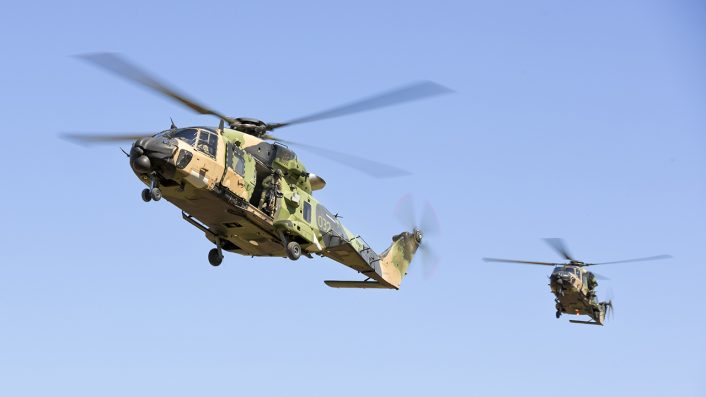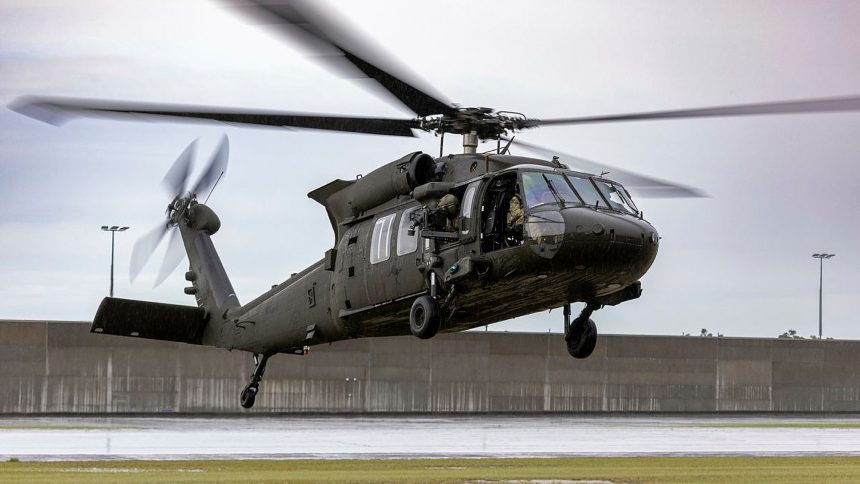Fifteen months after the Black Hawks entered service to replace the troubled MRH-90 Taipan, the Australian Army declared initial operating capability (IOC) with the Sikorsky UH-60M.
To date, 12 airframes have been delivered to Australia. Seven more will join the fleet in 2025, with the full order of 40 expected to be in service by 2030.
Australia selected the UH-60M Black Hawk in 2021, and the sale was subsequently approved by the United States in 2022. The helicopters were procured rapidly to replace the NHIndustries MRH-90 Taipan (also known as NH90) following several high profile crashes and widespread fleet unreliability.
Originally planned to stay in service until 2037, the Taipans never returned to Australian Army service following a grounding order in July 2023, and were withdrawn completely by September of the same year. Remaining airframes were subsequently stripped of valuable parts and then buried. The Royal Australian Navy’s (RAN) smaller fleet ceased operations in April 2022, and were replaced by an additional order of MH-60R Seahawks.

Deputy Prime Minister Richard Marles noted “The Albanese Government continues to invest in advanced capabilities for our Defence Force. These helicopters will contribute to the security of our nation and help keep Australians safe. The delivery of this capability signifies one of the fastest initial phases of a capability acquisition in recent times, and showcases the optimisation of the Australian Army in order to meet our strategic circumstances.”
Minister for Defence Industry and Capability Delivery Pat Conroy also spoke regarding the news: “The acquisition of these Black Hawks is a testament to the hard work and dedication of our teams across Defence and industry who have worked tirelessly to bring this capability into service”. He further spoke of Australia’s close cooperation with the United States, stating that the expedited procurement and delivery process “demonstrates the strength of our alliance with the United States”.
When delivered, the Black Hawks arrived on board U.S. Air Force C-17A Globemaster IIIs.
The first 3 of a planned fleet of 40 UH-60M Black Hawks arrived recently in Sydney on board two @usairforce C-17A Globemasters. The Black Hawks will undergo a short period of testing before they are ready to commence flying operations later this year. 💪🇦🇺🇺🇸#YourADF pic.twitter.com/P7OqKkTYkN
— Defence Australia (@DefenceAust) August 22, 2023
Australian officials say, following IOC, the UH-60Ms will now be available for taskings relating to counter-terrorism operations and emergencies. The Black Hawks join CH-47F Chinooks, AgustaWestland AW139s, and Eurocopter Tiger ARHs in the Australian Army’s combat helicopter fleet.
Notably, the Tiger helicopters, which were ordered around the same time as the MRH-90 Taipans, are also scheduled for early retirement due to high maintenance costs and supply chain issues. Seeking a ‘proven’, ‘mature’ replacement, the service selected Boeing’s AH-64E Apache Guardian in 2021. A total of 29 AH-64Es will be delivered, with 12 hoped to arrive by 2026 to allow IOC to be declared.
Ukraine, who were disappointed to not be able to take on the retiring Taipan fleet, has reportedly expressed an interest in obtaining Australia’s Tigers as they retire.
Though less so than the NH90/MRH-90, the Tiger has also had a mixed reception among its few operators. Alongside Australia, Germany has also announced that its Tigers will be retired early, bowing out in 2032 rather than 2038.
The NH90 has become well known for its operators facing multiple issues with the airframe. From corrosion and cracks discovered in the Netherlands NFH variant fleet, to an availability rate of only 19% among Finnish NH90s, and Norway deciding to part ways with the type altogether.
Other operators, including France, Italy, and Spain, have had fewer troubled times with the helicopter, with its performance in Spanish service having even been described as “perfect”.
Australia’s Subtle Realignment
While not necessarily related, the move from a European-sourced helicopter fleet to a U.S. one, as well as ministerial remarks regarding the nation’s close ties with the United States, come at a very notable time for Australia-U.S. relations.
The two nations are extremely close partners, already being part of the ANZUS security treaty (along with New Zealand), and Australia-US free trade agreement (AUSFTA), and, arguably, most importantly the Five Eyes intelligence alliance (with the United Kingdom, Canada, and New Zealand).
As a part of Five Eyes, Australia hosts a large satellite control and signals gathering ground station at Pine Gap, near Alice Springs. This jointly operated base is one of the key worldwide U.S. bases for satellite communications and communications interception.
More recently, the two close allies have furnished yet a new alliance, joining with the UK to form AUKUS. Tailored to countering a perceived emerging threat from the People’s Republic of China, key tenets include the permanent basing of U.S. Navy and Royal Navy nuclear powered submarines in Australia, alongside the procurement of nuclear-powered submarines for the Royal Australian Navy.
After visiting HMNB Clyde and @ForgemastersHQ , Defence Secretary @JohnHealey_MP presented 🇦🇺Australian Deputy Prime Minister @RichardMarlesMP with SSN-AUKUS model #AUKUS pic.twitter.com/5NQKOcIAee
— Navy Lookout (@NavyLookout) July 15, 2024
When announced, this struck a massive blow for Australian relations with France as it meant the termination of the order for Barracuda class conventionally powered submarines that would have originally served the RAN. The Barracuda is adapted from France’s nuclear powered Suffren design, and at the time Australia was its only overseas customer.
Instead, Australia will buy at least three Virginia class nuclear submarines from the U.S. to replace its existing diesel electric submarines. These will serve until the early 2040s, when Australia will begin commissioning locally built nuclear submarines of the same design as the Royal Navy’s planned Astute class replacements.
The Royal Australian Navy will also emulate the Royal Navy with its new frigates, which will be named Hunter class and based on the Type 26 design.
The three close allies are already all operators of the Boeing P-8A Poseidon, and soon this will extend to the E-7A Wedgetail. They also all operate the F-35 Lightning II, and many more pieces of equipment are shared by at least two of the three nations. This vastly helps the development of interoperability, allowing the sharing of maintenance and crew facilities at forward operating locations.
With the new U.S. administration, it would seem under current messaging that this alliance can count itself as relatively secure. While Europe and Ukraine fear a U.S. withdrawal and appeasement with Russia, an increased focus on countering China would bring the AUKUS alliance to the forefront.









